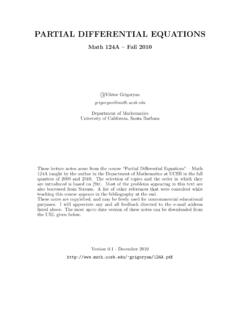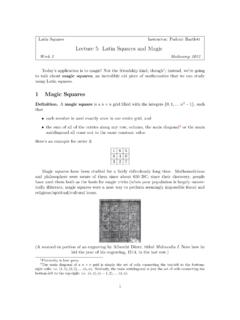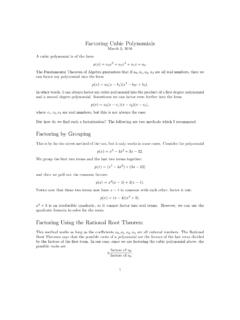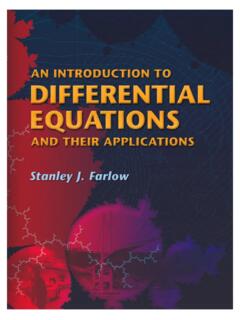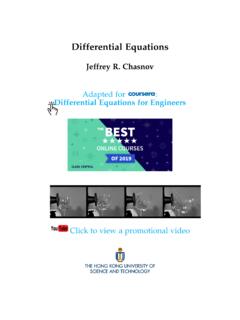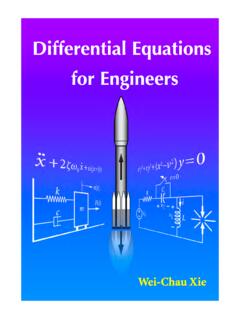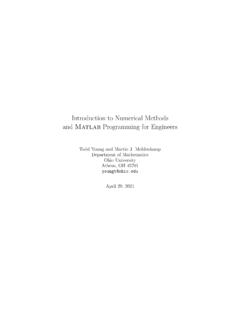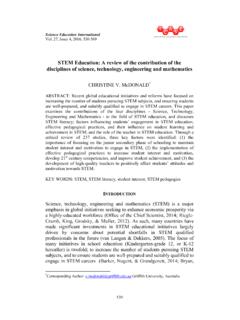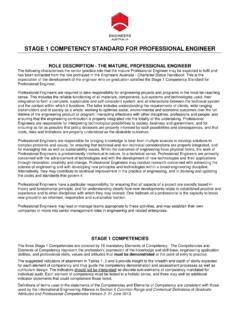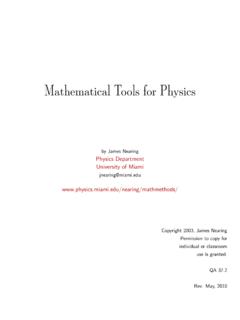Transcription of INTERNATIONAL SERIES IN PURE AND APPLIED …
1 INTERNATIONAL SERIES IN PURE AND APPLIED mathematics PRINCIPLES OF MATHEMATICAL ANALYSIS INTERNATIONAL SERIES IN PURE AND APPLIED mathematics William Ted Martin, E. H. Spanier, G. Springer and P. J. Davis. Consulting Editors AHLFORS: Complex Analysis BucK: Advanced Calculus BUSACKER AND SAATY: Finite Graphs and Networks CHENEY: Introduction to Approximation Theory CHESTER: Techniques in Partial Differential Equations CODDINGTON AND LEVINSON: Theory of Ordinary Differential Equations CONTE AND DE BooR: Elementary Numerical Analysis: An Algorithmic Approach DENNEMEYER: Introduction to Partial Differential Equations and Boundary Value Problems DETTMAN: Mathematical methods in Physics and Engineering GOLOMB AND SHANKS: Elements of Ordinary Differential Equations GREENSPAN: Introduction to Partial Differential Equations HAMMING: Numerical methods for Scientists and Engineers HILDEBRAND: Introduction to Numerical Analysis HousEHOLDER: The Numerical Treatment of a Single Nonlinear Equation KALMAN, FALB, AND ARBIB: Topics in Mathematical Systems Theory LASS: Vector and Tensor Analysis McCARTY: Topology.
2 An Introduction with Applications to Topological Groups MONK: Introduction to Set Theory MOORE: Elements of Linear Algebra and Matrix Theory MosTOW AND SAMPSON: Linear Algebra MouRSUND AND DURIS: Elementary Theory and Application of Numerical Analysis PEARL: Matrix Theory and Finite mathematics PIPES AND HARVILL: APPLIED mathematics for Engineers and Physicists RALSTON: A First Course in Numerical Analysis RITGER AND RosE: Differential Equations with Applications RITT: Fourier SERIES RUDIN: Principles of Mathematical Analysis SHAPIRO: Introduction to Abstract Algebra SIMMONS: Differential Equations with Applications and Historical Notes SIMMONS: Introduction to Topology and Modern Analysis SNEDDON: Elements of Partial Differential Equations STRUBLE: Nonlinear Differential Equations McGraw-Hill, Inc. New York St. Louis San Francisco Auckland Bogota Caracas Lisbon London Madrid Mexico City Milan Montreal New Delhi San Juan Singapore Sydney Tokyo Toronto WALTER RUDIN Professor of mathematics University of Wisconsin,-Madison THIRD EDITION This book was set in Times New Roman.
3 The editors were A. Anthony Arthur and Shelly Levine Langman; the production supervisor was Leroy A. Young. R. R. Donnelley & Sons Company was printer and binder. This book is printed on acid-free paper. Library of Congress Cataloging in Publication Data Rudin, Walter, date Principles of mathematical analysis. ( INTERNATIONAL SERIES in pure and APPLIED mathematics ) Bibliography: p. Includes index. 1. Mathematical analysis. I. Title. 1976 515 75-17903 ISBN 0-07-054235-X PRINCIPLES OF MATHEMATICAL ANALYSIS Copyright 1964, 1976 by McGraw-Hill, Inc. Al] rights reserved. Copyright 1953 by McGraw-Hill, Inc. All rights reserved. Printed in the United States of America. No part of this publication may be reproduced, stored in a retrieval system, or transmitted, in any form or by any means, electronic, mechanical, photocopying, recording, or otherwise, without the prior written permission of the publisher. 28 29 30 DOC/DOC O 9 8 7 6 5 4 3 2 1 0 Preface Chapter 1 The Real and Complex Number Systems Introduction Ordered Sets Fields The Real Field The Extended Real Number System The Complex Field Euclidean Spaces Appendix Exercises Chapter 2 Basic Topology Finite, Countable.
4 And Uncountable Sets Metric Spaces Compact Sets Perfect Sets CONTENTS lX 1 1 3 5 8 11 12 16 17 21 24 24 30 36 41 Vi CONTENTS Connected Sets Exercises Chapter 3 Numerical Sequences and SERIES Convergent Sequences Subsequences Cauchy Sequences Upper and Lower Limits Some Special Sequences SERIES SERIES of Nonnegative Terms The Number e The Root and Ratio Tests Power SERIES Summation by Parts Absolute Convergence Addition and Multiplication of SERIES Rearrangements Exercises Chapter 4 Continuity Limits of Functions Continuous Fur1ctions Continuity and Compactness Continuity and Connectedness Discontinuities Monotonic Functions Infinite Limits and Limits at Infinity Exercises Chapter 5 Differentiation The Derivative of a Real Function Mean Value Theorems The Continuity of Derivatives L'Hospital's Rule Derivatives of Higher Order Taylor's Theorem Differentiation of Vector-valued Functions Exercises 42 43 47 47 51 52 55 57 58 61 63 65 69 70 71 72 75 78 83 83 85 89 93 94 95 97 98 103 103 107 108 109 110 110 111 114 Chapter 6 The Riemann-Stieltjes Integral Definition and Existence of the Integral Properties of the Integral Integration and Differentiation Integration of Vector-valued Functions Rectifiable Curves Exercises Chapter 7 Sequences and SERIES of Functions.
5 Discussion of Main Problem Uniform Convergence Uniform Convergence and Continuity Uniform Convergence and Integration Uniform Convergence and Differentiation Equicontinuous Families of Functions The Stone-Weierstrass Theorem Exercises Chapter 8 Some Special Functions Power SERIES The Exponential and Logarithmic Functions The Trigonometric Functions The Algebraic Completeness of the Complex Field Fourier SERIES The Gamma Function Exercises Chapter 9 Functions of Several Variables Linear Transformations Differentiation The Contraction Principle The Inverse Function Theorem The Implicit Function Theorem The Rank Theorem Determinants Derivatives of Higher Order Differentiation of Integrals Exercises Chapter 10 Integration of Differential Forms Integration CONTENTS vii 120 120 128 133 135 136 138 143 143 147 149 151 152 154 159 165 172 172 178 182 184 185 192 196 204 204 211 220 221 223 228 231 235 236 239 245 245 YID CONTENTS Primitive Mappings Partitions of Unity Change of Variables Differential Forms Simplexes and Chains Stokes' Theorem Closed Forms and Exact Forms Vector Analysis Exercises Chapter 11 The Lebesgue Theory Set Functions Construction of the Lebesgue Measure Measure Spaces Measurable Functions Simple Functions Integration Comparison with the Riemann Integral Integration of Complex Functions Functions of Class !
6 T'2 Exercises Blbllograpby List of Special Symbols Index 248 251 252 253 266 273 275 280 288 300 300 302 310 310 313 314 322 325 325 332 335 337 339 PREFACE This book is intended to serve as a text for the course in analysis that is usually taken by advanced undergraduates or by first-year students who study mathe-matics. The present edition covers essentially the same topics as the second one, with some additions, a few minor omissions, and considerable rearrangement. I hope that these changes will make the material more accessible amd more attrac-tive to the students who take such a course. Experience has convinced me that it is pedagogically unsound (though logically correct) to start off with the construction of the real numbers from the rational ones. At the beginning, most students simply fail to appreciate the need for doing this. Accordingly, the real number system is introduced as an ordered field with the least-upper-bound property, and a few interesting applications of this property are quickly made.
7 However, Dedekind's construction is not omit-ted. It is now in an Appendix to Chapter I, where it may be studied and enjoyed whenever the time seems ripe. The material on functions of several variables is almost completely re-written, with many details filled in, and with more examples and more motiva-tion. The proof of the inverse function theorem-the key item in Chapter 9'-iS X PREFACE simplified by means of the fixed point theorem about contraction mappings. Differential forms are discussed in much greater detail. Several applications of Stokes' theorem are included. As regards other changes, the chapter on the Riemann-Stieltjes integral has been trimmed a bit, a short do-it-yourself section on the gamma function has been added to Chapter 8, and there is a large number of new exercises, most of them with fairly detailed hints. I have also included several references to articles appearing in the American Mathematical Monthly and in mathematics Magazine, in the hope that students will develop the habit of looking into the journal literature.
8 Most of these references were kindly supplied by R. B. Burckel. Over the years, many people, students as well as teachers, have sent me corrections, criticisms, and other comments concerning the previous editions of this book. I have appreciated these, and I take this opportunity to express my sincere thanks to all who have written me. WALTER RUDIN THE REAL AND COMPLEX NUMBER SYSTEMS INTRODUCTION A satisfactory discussion of the main concepts of analysis (such as convergence, continuity, differentiation, and integration) must be based on an accurately defined number concept. We shall not, however, enter into any discussion of the axioms that govern the arithmetic of the integers, but assume familiarity with the rational numbers ( , the numbers of the form m/n, where m and n are integers and n =fi 0). The rational number system is inadequate for many purposes, both as a field and as an ordered set. (These terms will be defined in Secs. and ) For instance, there is no rational p such that p2 = 2.
9 (We shall prove this presently.) This leads to the introduction of so-called ''irrational numbers'' which are often written as infinite decimal expansions and are considered to be ''approximated'' by the corresponding finite decimals. Thus the sequence 1, , , , , .. ''tends to J2." But unless the irrational number J2 has been clearly defined, the question must arise: Just what is it that this sequence ''tends to''? 2 PRINCIPLES OF MATHEMATICAL ANALYSI~ This sort of question can be answered as soon as the so-called ''real number system'' is constructed. Example We now show that the equation (1) p2 = 2 is not satisfied by any rational p. If there were such a p, we could write p = m/n where m and n are integers that are not both even. Let us assume this is done. Then (1) implies (2) m2 = 2n2, This shows that m2 is even. Hence m is even (if m were odd, m2 would be odd), and so m2 is divisible by 4. It follows that the right side of (2) is divisible by 4, so that n2 is even, which implies that n is even.
10 The assumption that (1) holds thus leads to the conclusion that both m and n are even, contrary to our choice of m and n. Hence (I) is impossible for rational p. We now examine this situation a little more closely. Let A be the set of all positive rationals p such that p2 < 2 and let B consist of all positive rationals p such that p2 > 2. We shall show that A contains no largest number and B con-tains no smallest. More explicitly, for every pin A we can find a rational q in A such that p < q, and for every p in B we can find a rational q in B such that q < p. (3) Then (4) To do this, we associate with each rational p > 0 the number p2 -2 2p + 2 q=p-= . p+2 p+2 2 2 -2(p2 -2) q --(p + 2)2 . If p is in A then p2 -2 < 0, (3) shows that q > p, and (4) shows that q2 < 2. Thus q is in A. If pis in B then p2 -2 > 0, (3) shows that O < q < p, and (4) shows that q2 > 2. Thus q is in B. Remark The purpose of the above discussion has been to show that the rational number system has certain gaps, in spite of the fact that between any two rationals there is another: If r < s then r < (r + s)/2 < s.
